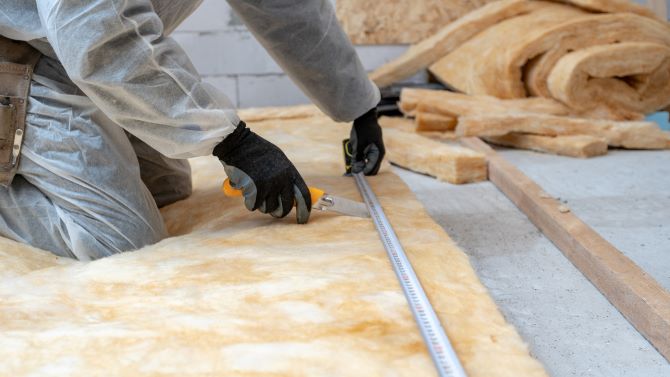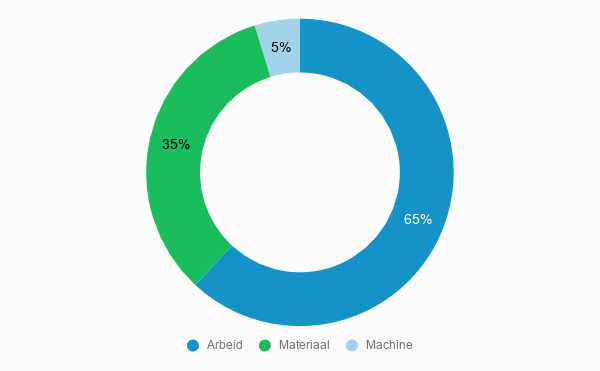Want to get rid of your cold floors and prevent heat from continuously leaving your home through the floor? Then floor insulation could be the solution. How high are floor insulation prices? And can you also claim a subsidy? Renoca has collected all price-related information and made it easy for you.
What does floor insulation cost?
You can insulate floors in different ways. Crawl space insulation is the most common method used to insulate the floor on the ground floor. In the absence of a (suitable) crawl space, insulation via the top of the floor is possible. This method is also suitable for insulating upper floors.
The average price for your situation also depends on the number of m2 you have insulated and which insulation material is used. The price chart below gives an indication of the likely prices of insulating the floor on the ground floor.
| Type of dwelling | Basement | Crawl space |
|---|---|---|
| Appartment (50 m2) | £1.600 – £2,800 | £2,500 – £3,500 |
| Apartment (50 m2) | £1.600 – £ 2,800 | £ 2,500 – £ 3,500 |
| Corner house / semi-detached (60 m2) | £ 1,900 – £ 3,300 | £ 3,000 – £ 4.200 |
| Detached house (75 m2) | £ 2,400 – £ 4,100 | £ 3,700 – £ 5,200 |
Do you want more information on the options around floor insulation? Then read our article on floor insulation.
Floor insulation not an option? Then consider floor insulation
Not all homes have a suitable crawl space. For example, there are homes with a crawl space lower than 35 centimetres, which also cannot be excavated or has no entrance. To still be able to save energy, bottom insulation is then an option. This involves placing insulation material on the bottom of the crawl space. Insulating beads or chips are injected into the crawl space with a hose through the crawl space hatch or a temporary hole in the wall (in the absence of a crawl space hatch).
Be aware that the effect of bottom insulation is less than that of floor insulation. This is because with bottom insulation, you keep a layer of air between the insulation material and the floor. This air is ventilated and cold. As a result, you will still lose some heat through the floor.
Find the best specialist for your project and get free quotes.
Start

Price examples
We outline a number of situations with corresponding price indications to give you a better idea of the floor insulation prices you can expect for different choices.
Dwellings with a suitable crawl space
You live in a detached house and basically always suffer from a cold floor. The energy costs are also quite high. After doing some research, you discover that the floor is not properly insulated. But the crawl space under your house is in good condition. Then you opt for crawl space insulation for an amount around £2,500 to £4,000 for 75 m2.
An flat without a crawl space
You have a nice flat, but it is often too cold and difficult to get comfortable. Since there is no crawl space, insulating the underside of the floor is not an option. Therefore, you decide to install insulation on the concrete structural floor. After an investment of around £5,000 for 50 m2, your flat is back to your liking.
How are floor insulation prices structured?

Floor insulation prices are made up of three cost items: labour, material and machine costs. Generally, you will spend the most on labour costs, but depending on the material you choose, material costs can also take up a large percentage of the total cost. This is because some materials are more expensive, but quicker to install.
The VAT rate on floor insulation
If you have floor insulation installed by an insulation company, you will benefit from an extra advantageous VAT rate. If you insulate your home to make it more energy efficient, you will pay 9% VAT on the labour costs instead of the usual 21%. The condition is that the house is at least two years old. The VAT reduction also only applies to labour costs; insulation materials, for example, are subject to the 21% VAT rate.
Subsidy for floor insulation
Are you having floor insulation installed by a specialist? If so, you may be eligible for a subsidy. Your subsidy doubles if you add a second energy-saving measure. This could be a second insulating measure such as roof insulation, insulating glass or cavity wall insulation, or a water pump, solar boiler or a connection to a heat network.
The subsidy is subject to conditions. For example, you must live in the house yourself and the subsidy must be applied for in time after carrying out the first measure. You must also achieve an insulation value of 3.5 Rd for floor insulation and there are rules for the minimum and maximum number of m2 covered by the scheme. An overview of all conditions and rules, together with a step-by-step plan, can be found on the website of the RVO.
The subsidy for floor insulation is currently £5.50 per m2 for an implementation date after 2 April 2022 and remains the same in 2023. For attic floors or lofts, this amount is £4 per m2 and for floor insulation £3 per m2.
There are also local subsidy options. Want to know whether your municipality, water board or province provides subsidies for insulation? Then check out the Energy Subsidy Guide.

What factors affect the total price of floor insulation?
There are many factors that affect the total cost of your project. Whether you do the project yourself, have it done and the size of your home are some examples. The following factors also all influence the final floor insulation prices:
Influence 1: Do you opt for top-floor insulation or crawl space insulation?
Do you go for top-floor insulation or crawl space insulation after all? The latter is cheaper on average, but is not always possible. If you want to insulate the attic floor or another storey floor, you will need top-floor insulation anyway. Decide for yourself what is important and make your choice on that basis.
Influence 2: Which insulation material do you choose?
For floor insulation, you can choose from a variety of materials. Often blankets or boards are the type of insulation used. For crawl space insulation, foam or insulation pads are also options. Are you going to insulate on top of a concrete floor?
You can go for materials such as PUR foam, PIR boards or EPS beads, or natural materials such as flax, cork, hemp and mineral wool. The choices are endless.
We list a few options. Compare insulation materials on features that are important to you, or seek advice from a specialist.
- PUR foam has the highest insulation value of all frequently used materials. It also provides a moisture- and airtight seal and is also suitable for hard-to-reach areas, including thus the underside of the floor.
- Isolation cushions also have a high insulation value. These cushions contain two or three layers of air and are lightweight. Insulation cushions are suitable for insulating the underside of a floor. Beware of damage though; insulation cushions are made of fragile material.
- Insulation boards can be divided into different types of material. For example, you have sheets made of EPS (Styrofoam), glass wool or rock wool. These materials all insulate very well. A slight disadvantage of insulation boards is that there are often small gaps and seams between them, which still allows a small amount of heat to escape. This is solved by taping or spraying the seams. Stone wool and glass wool are more fire-safe than EPS.
Incentive 3: Are you adding any additional options?
There are also a host of choices that are not necessary for your project, but may be interesting to consider. For example, make your feet extra happy by not only insulating your floor, but also heating it.
| Extra option | Average prices | Advantage |
|---|---|---|
| Floor heating | £750 per 10m² | More space, warm floor |
| CV pipe insulation | £15 per 30m pipe | Lower heat loss so lower heating costs |
Find the best specialist for your project and get free quotes.
Start